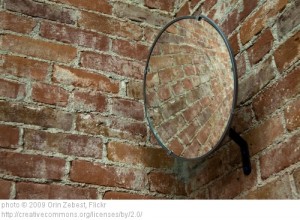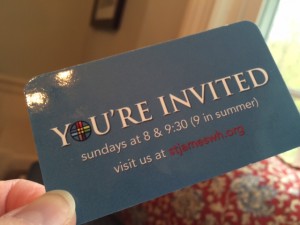Having a body that defies cultural norms as mine does (it is crooked, uneven, lumpy, and limpy) can be alienating. The regular absence of anyone who looks like me in my daily routine creates a space that can fill with either negative feelings (shame, frustration, grief) or positive (pride in the scars that testify to my survival through pain). But even when I’m in a good frame of mind, a sense of loneliness—of being an “other”—persists. This is why I love swimming laps at my local indoor pool, where aged and infirm bodies are the norm. This is why, when I attend gatherings of people with OI (my bone disorder), I feel a new lightness and confidence. A scene from my book, No Easy Choice, as we checked into the hotel at an OI Foundation National Conference:
I glanced up and saw a young women. She was less than five feet tall, with a square and thick torso over thin legs, and shoulder-length brown hair. She was pushing a baby stroller that came up too high on her, to her chest, making her look even smaller. I stared for just a moment, not long enough for her to notice, taking her in. I had never seen another mother who looked just like me. As I looked at her, all the strain I didn’t even know I was carrying around, all the self-consciousness of being a tiny, crooked, fragile mom in a world of tall, straight, strong moms—it all fell away. Here was a mom who looked just like me. And she was beautiful, capable, and strong. Which meant I must be beautiful, capable, and strong too—as strong as those moms who effortlessly dangle an infant seat on one arm while balancing a toddler on the opposite hip—because lifting and carrying and bending over to bathe my children are acts of will and courage as much as they are acts of strength.
 The writer Junot Diaz has said, “”If you want to make a human being into a monster, deny them, at the cultural level, any reflection of themselves.” A disconnect with cultural norms, whether of physical appearance or cognitive ability or social interactions, is behind many of our fears and misconceptions about life with disabilities. The Diaz quote introduces a moving video, in which a half dozen people with various physical impairments modeled for mannequins made in their images. The models, seeing their mannequins for the first time, are transformed; their eyes light up, they hold their heads a notch higher. Passers-by, too, exhibit surprise and transformation, stopping to cock their heads, take a good long look, nod their approval. Check out the video and accompanying article.
The writer Junot Diaz has said, “”If you want to make a human being into a monster, deny them, at the cultural level, any reflection of themselves.” A disconnect with cultural norms, whether of physical appearance or cognitive ability or social interactions, is behind many of our fears and misconceptions about life with disabilities. The Diaz quote introduces a moving video, in which a half dozen people with various physical impairments modeled for mannequins made in their images. The models, seeing their mannequins for the first time, are transformed; their eyes light up, they hold their heads a notch higher. Passers-by, too, exhibit surprise and transformation, stopping to cock their heads, take a good long look, nod their approval. Check out the video and accompanying article.
Watching this video was particularly powerful to me for two reasons. First, two of the models have physical characteristics very similar to mine (crooked back, leg-length discrepancies, skinny arms and legs), so I once again felt the lightness and confidence that comes with seeing oneself—ones’ unusual, different self—reflected in another. Second, I watched this video just a day or two after returning from a brief hospitalization.
On a Sunday morning two weeks ago, I stepped outside onto the wet front walk to get the newspaper, and found out too late that what looked wet was actually a sheet of ice. I landed hard on my back, breaking two ribs and a small bone in my shoulder socket, and collapsing part of my lung. I spent about 36 hours in the hospital for observation, pain management, and supplemental oxygen.
Hospitalization is a physically vulnerable experience for anyone, no matter the shape, size, or condition of your body. Loose gowns flap open. Clinicians inquire about your bladder and bowel habits. X-ray technicians and orderlies and phlebotomists and aides push and poke and prod and don’t blink an eye at a flash of underwear or bare breasts. Multiple people regularly examined a part of my body about which I am particularly self-conscious—my crooked, lumpy back. More than once, I wished I had one of those straight, muscular backs that my taller, athletic peers have.
So it was embarrassing, yes. But my embarrassment was tempered by the care of professionals who did everything they possibly could to ease my discomfort. I’m thinking particularly of a young West Indian man who came to my room early one morning to take me down for an X-ray. (Side note: Every single practitioner who cared for me in the hospital, other than the doctors, was either of West Indian/Caribbean or Eastern European descent.) Because of intense pain, I could barely shift position in bed, and here I had to get up out of bed and get myself onto a stretcher to be wheeled downstairs. The orderly reached out his gloved hands, which I grasped. He took tiny steps backward, leading me gently forward. I was unshowered, dressed only in a gown wide open in back, and taking mincing, unsteady steps. It was not my finest hour. But while I was a little embarrassed and a lot uncomfortable, I was also impressed by how this orderly—and all the others who cared for me those two days—did his job with quiet respect and skill. While there was no one in whom I could see my own reflection directly (no one who looked like me), the hospital is a place where weakness, vulnerability, and dependence are the norm. In that sense, the hospital was a place—like my swimming pool, like OI Foundation conferences, like the room where models with disabilities saw “their” mannequins unveiled—where people with impairments, scars, and obvious needs are not singled out as either remarkably sad or especially heroic, but are simply accepted and celebrated and attended to as we are.
To see oneself reflected in another is powerful; such experiences help us to love ourselves just as we are, to feel less alienated and more connected, to express needs and accept help without shame, to feel fully human. Perhaps this is why the incarnation happened, because God knew the transforming power of seeing ourselves reflected in the face of another.











